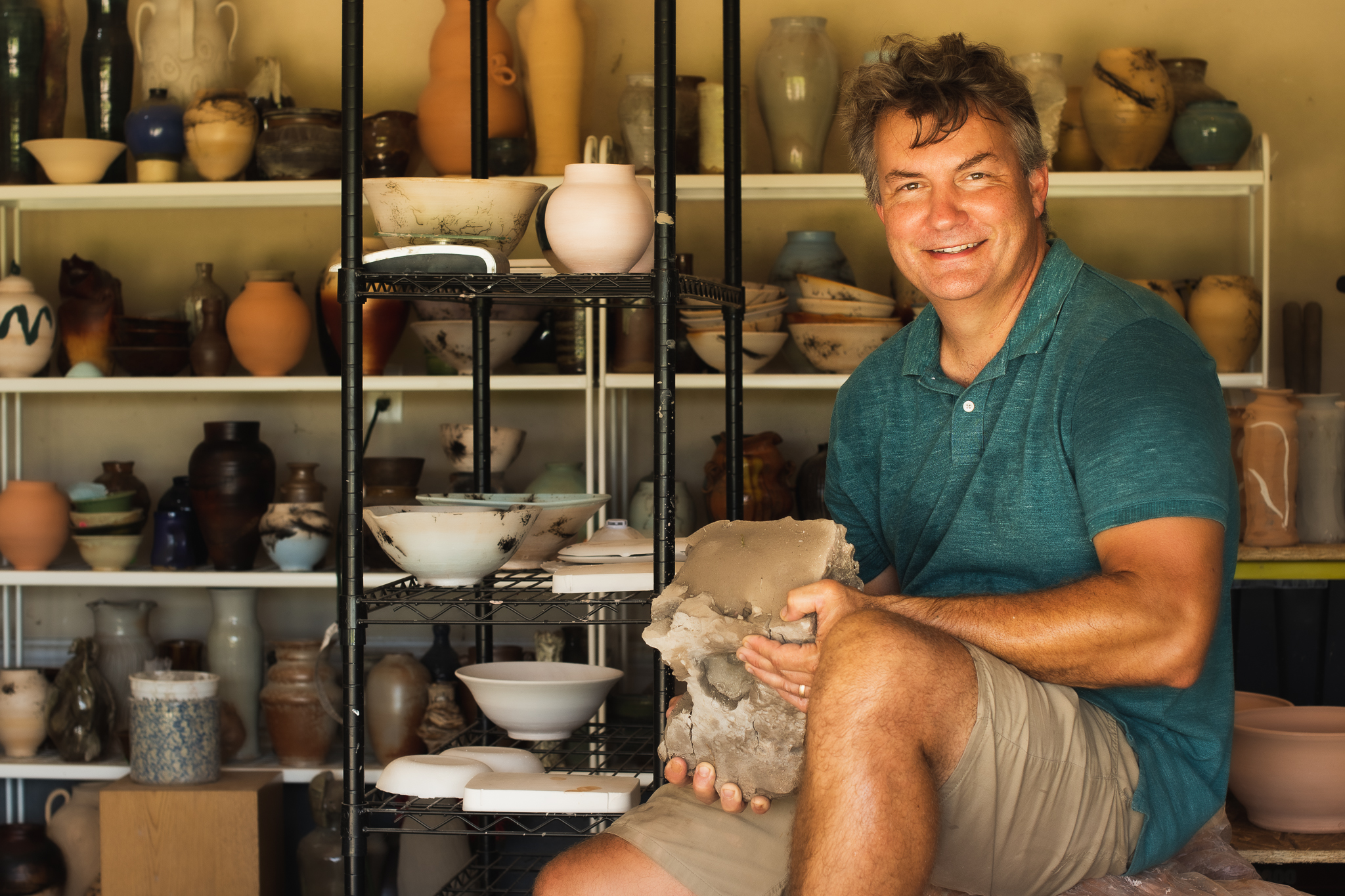
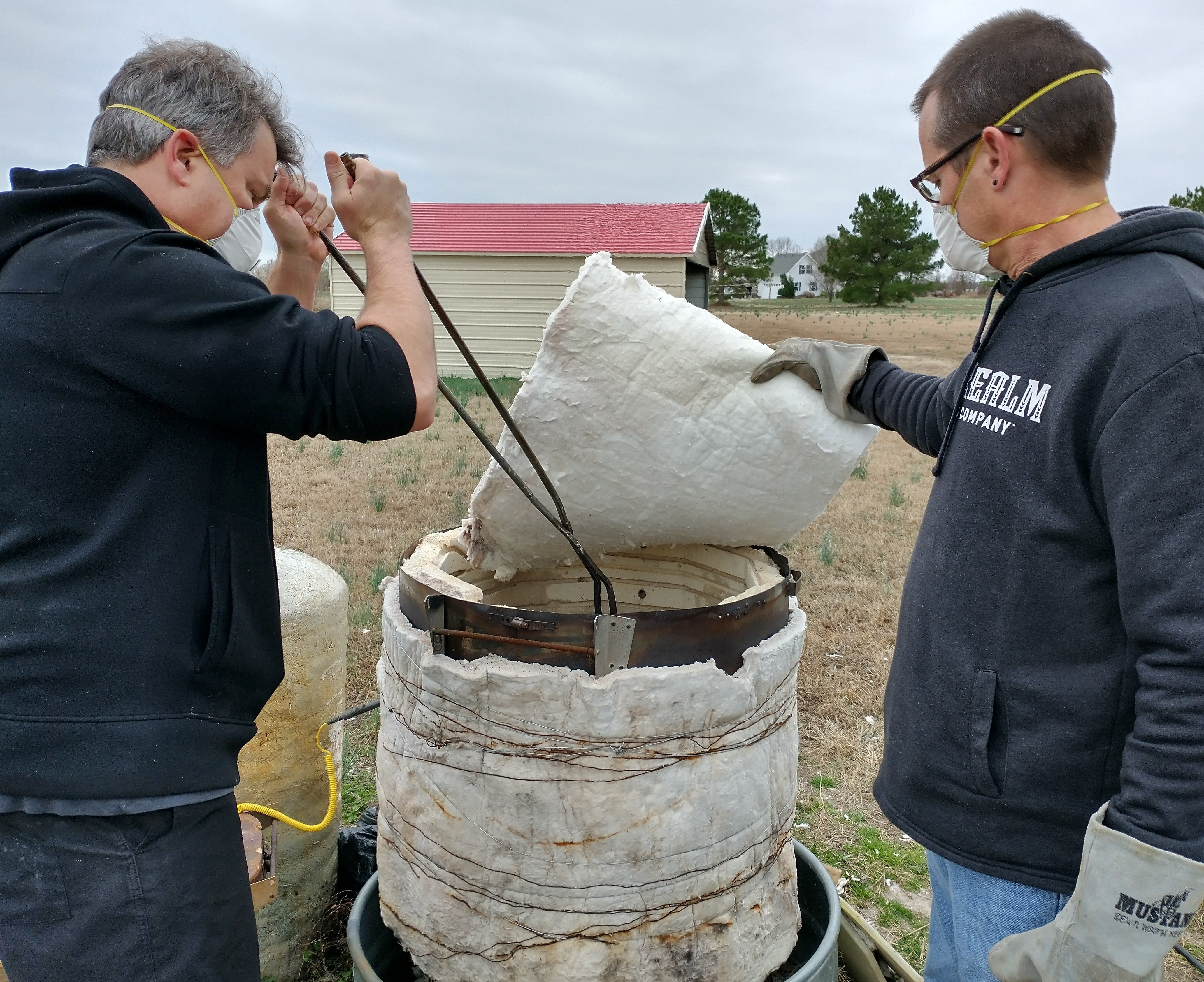 Mike Middleton and Jeff Winstead remove a Christmas ornament from a gas-fired kiln.
Mike Middleton and Jeff Winstead remove a Christmas ornament from a gas-fired kiln.
Michael Middleton reached with tongs into the fiery hot kiln to extract pottery shaped like a horse’s head.
The piece was small, bone white and flat, patterned after a photo of Kitty Hawk, a wild horse well known for unsanctioned romps with five other horses through Corolla village.
Middleton quickly placed the piece on a metal table, grabbed a pinch of fuzzy undercoat of a wild horse and held it close. The hair instantly melted onto the surface in an unpredictable squiggly pattern.
He’s made hundreds of these as Christmas decorations in the last few years as he expanded his inventory of pottery.
“We’re coming up with ideas all the time,” Middleton said. “Always trying to come up with the next thing.”
He and his assistant, Jeff Winstead, work together at Middleton’s Moyock home and property of about five acres to form and fire unique clay pots, vases, bottles, mugs and ornaments. Under the name of Michael Middleton Ceramics, he produces about 2,000 pieces a year.
An art teacher at Hickory High School in Chesapeake, Middleton has sold his work to customers all of the world including Japan, England and the Netherlands. Winstead teaches history at Hickory High School.
One of Middleton’s pots is on display at the International Museum of the Horse in Lexington, Kentucky. Thin black swirling lines formed from wild horse hair burned into the glaze accent the round, earth-toned pot. The hair came from the late wild horse named Captain, a stallion who lived on the Outer Banks for some 25 years before spending his last days at a farm in Grandy operated by the Corolla Wild Horse Fund.
Middleton makes his pottery of natural clay from western North Carolina, Currituck County and Chesapeake, Virginia.
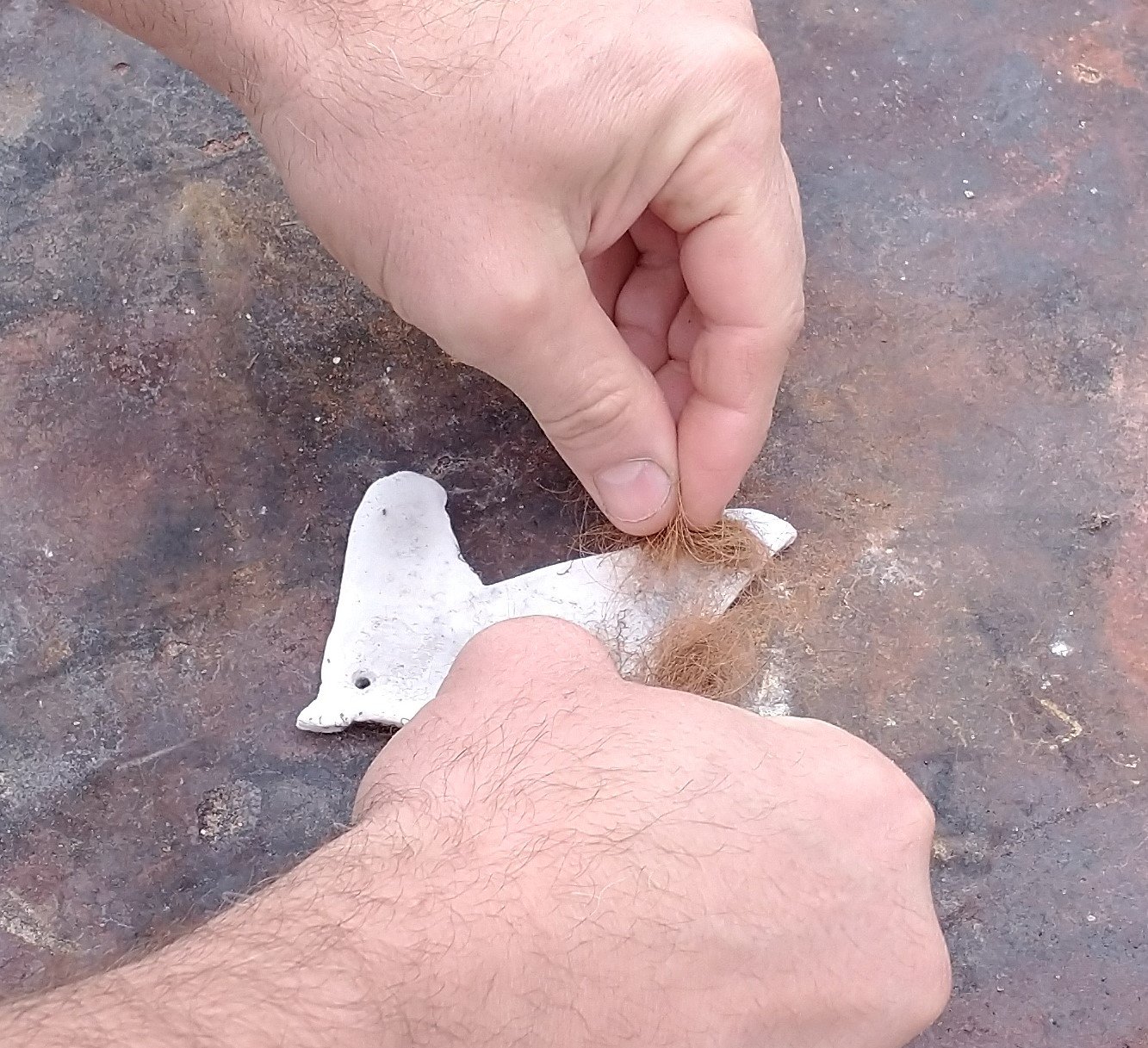 Mike Middleton applies the fuzzy winter coat hair of wild horse to a freshly heated
Mike Middleton applies the fuzzy winter coat hair of wild horse to a freshly heated
Christmas ornament patterned after a stallion named Captain.
For his wild horse-hair pots, he and Winstead shovel bucket loads of natural Currituck County clay from the back area of a neighbor’s property and transport it in the bed of a pickup truck to his yard.
A native American pot nearly 2,000 years old inspired him to work with the less-than-ideal local Currituck clay. The pot is on display at the Museum of the Albemarle in Elizabeth City.
The brown muck must dry for days to rid it of bacteria. He mixes it with water again and then filters it through cloth, leaving behind debris and most of the sand found in the soil.
Once it dries again, he adds clay powder and and a mineral called kyanite to strengthen it and transform Currituck clay into something useful.
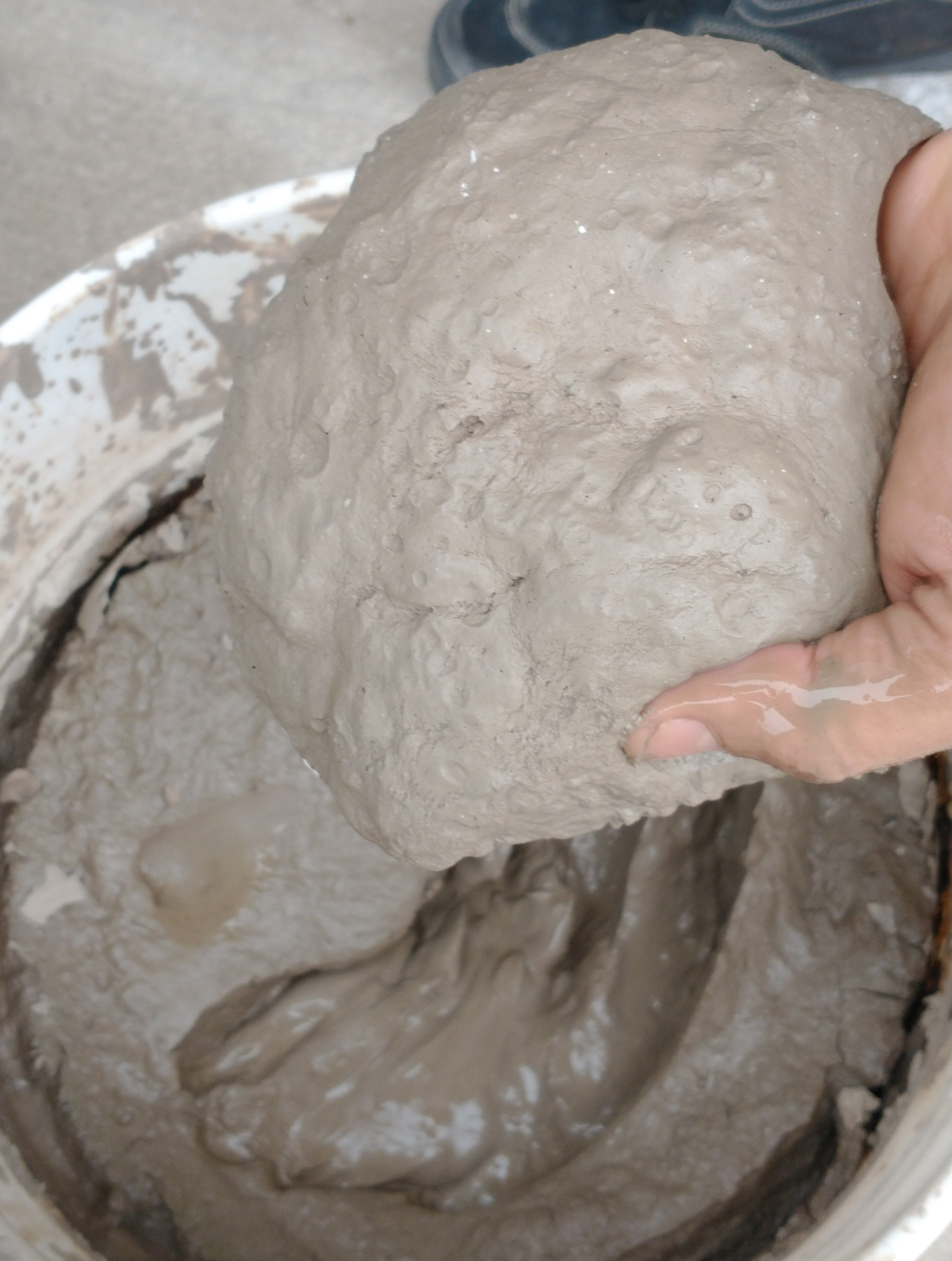 Currituck clay dug from a pasture near Mike Middleton's property takes a lot of effort to make it usable.
Currituck clay dug from a pasture near Mike Middleton's property takes a lot of effort to make it usable.
“It’s an ugly clay that nobody else wanted,” he said.
He gets a regular supply of hair from the wild horses living at the Grandy farm. The staff collects bags of it from brushing their coats, manes and tails.
Making the pots is laborious. After hours of standing over a potters wheel, his back hurts. The skin on his hands dries from frequently manipulating and shaping wet clay and grit gets under his fingernails.
Once he has formed a pot, he fires the clay first temperatures approaching 2,000 degrees. Afterward, he removes it and allows it to cool. Then, he applies a glaze. Later, he fires the pot again at about 1,300 degrees, he said.
He extracts the pot with tongs and in seconds uses his bare fingers to hold horse-hair strands close to the surface. The hair seers instantly into a carbon print of black lines spreading in unpredictable directions. He cannot control the exact design, which is part of the fun of it.
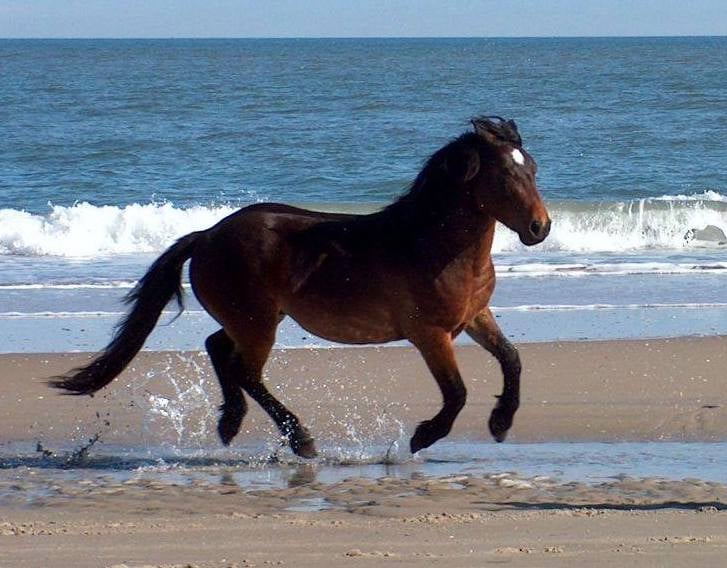 Roamer running wild on the beaches of Corolla. / corollawildhorses.org
Roamer running wild on the beaches of Corolla. / corollawildhorses.org
He made his first horse-hair pot four years ago using strands from a famous wild horse named Roamer. The stallion frequently circumvented the fence intended to keep him out of the Corolla village. He was a regular in the neighborhoods and the subject of hundreds of photographs. Currituck County used his image on billboards and advertising brochures.
Pots with the late Roamer’s hair are becoming a collector’s item.
The pots memorialize many famous wild horses.
For the Christmas ornament, Middleton drew a silhouette of Kitty Hawk’s profile from a photograph. A company made a cookie cutter from the drawing which he uses to quickly stamp the shape in rolled out clay.
Middleton sold nearly 100 pots in three days made with hair from Raymond the Mule. The offspring of a wild mare and a donkey brought to Currituck, Raymond roamed the Outer Banks for more than 20 years. He became famous for acting like a stallion and fighting for his small harem of mares despite not being able to reproduce.
His awkward bray could be heard echoing over the dunes. As he aged, he developed leg and hoof problems and was moved to the Grandy farm. Pots with his hair burned into the glaze continue his famous legacy.
A portion of the proceeds from the pots go to the Corolla Wild Horse Fund. The pots are on sale at the group’s gift shop in Corolla. The name of the horse from which the hair came from is marked on the bottom of the pots.
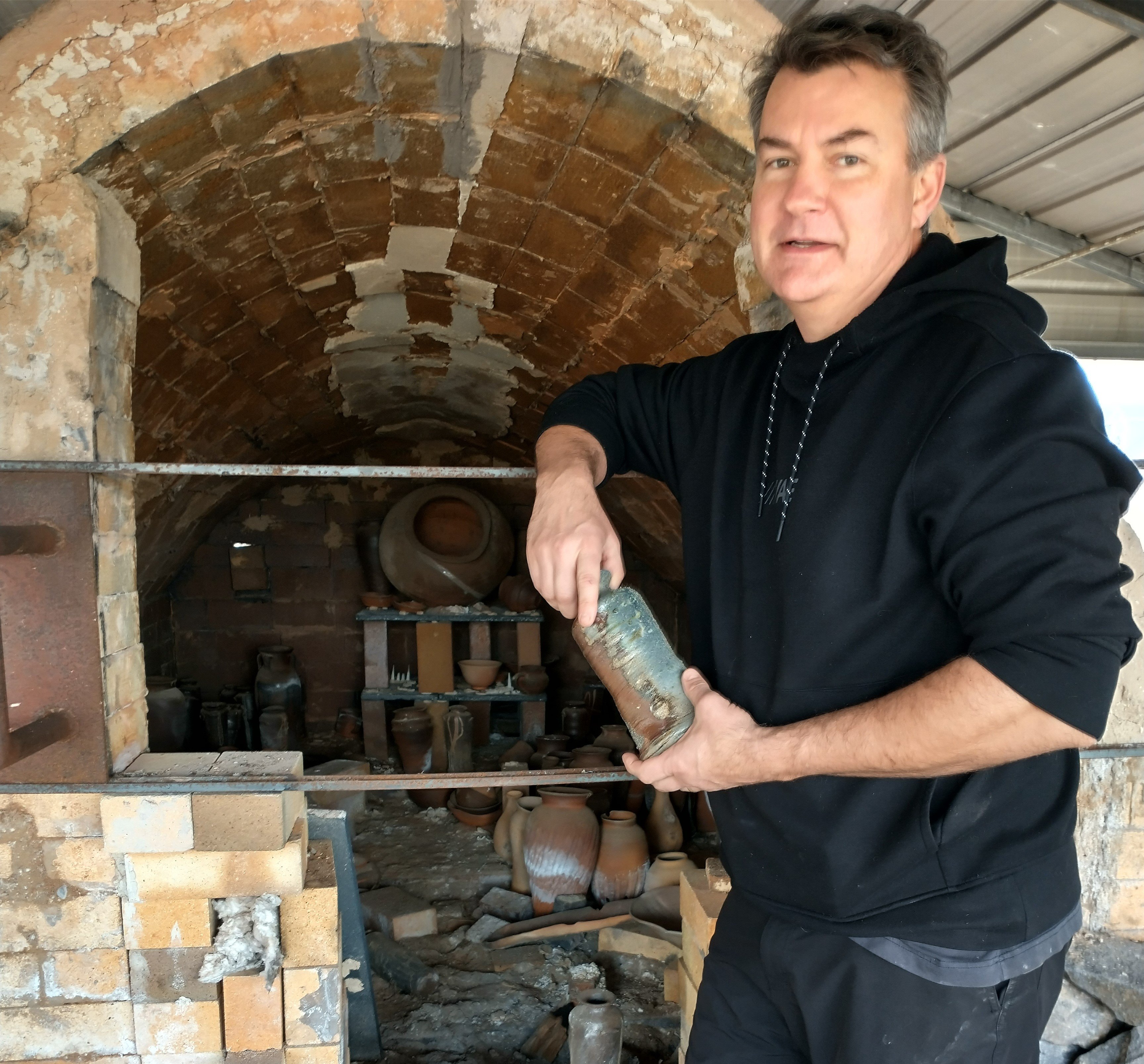
Middleton returns home from school and begins work that at times takes him and Winstead into the late hours as they dig up the clay soil, mix and work it. They manhandle and manipulate the variety of kilns and exchange ideas on new products.
Winstead makes no claim to artistic expertise, but enjoys helping Middleton. He calls himself "the minion." Middleton calls him his creative manager and maintains he’s invaluable to the work.
Two years ago, during the pandemic shutdown, the pair built a large, wood-fired kiln from about 2,000 bricks. It was one of the hottest, hardest jobs either of these school teachers had ever done.
They sweated out days reaching over 100 degrees laboring to place bricks correctly, especially in forming them into an arch at the top. Perhaps they labored too much. Middleton acknowledges the kiln is too big and he plans to wall off part of it.
“There is definitely a learning curve,” he said.
An assortment of pots sits within the kiln that looks something like a cave containing ancient pottery. An open-sided metal shelter helps protect the kiln and the crafters from sun and rain.
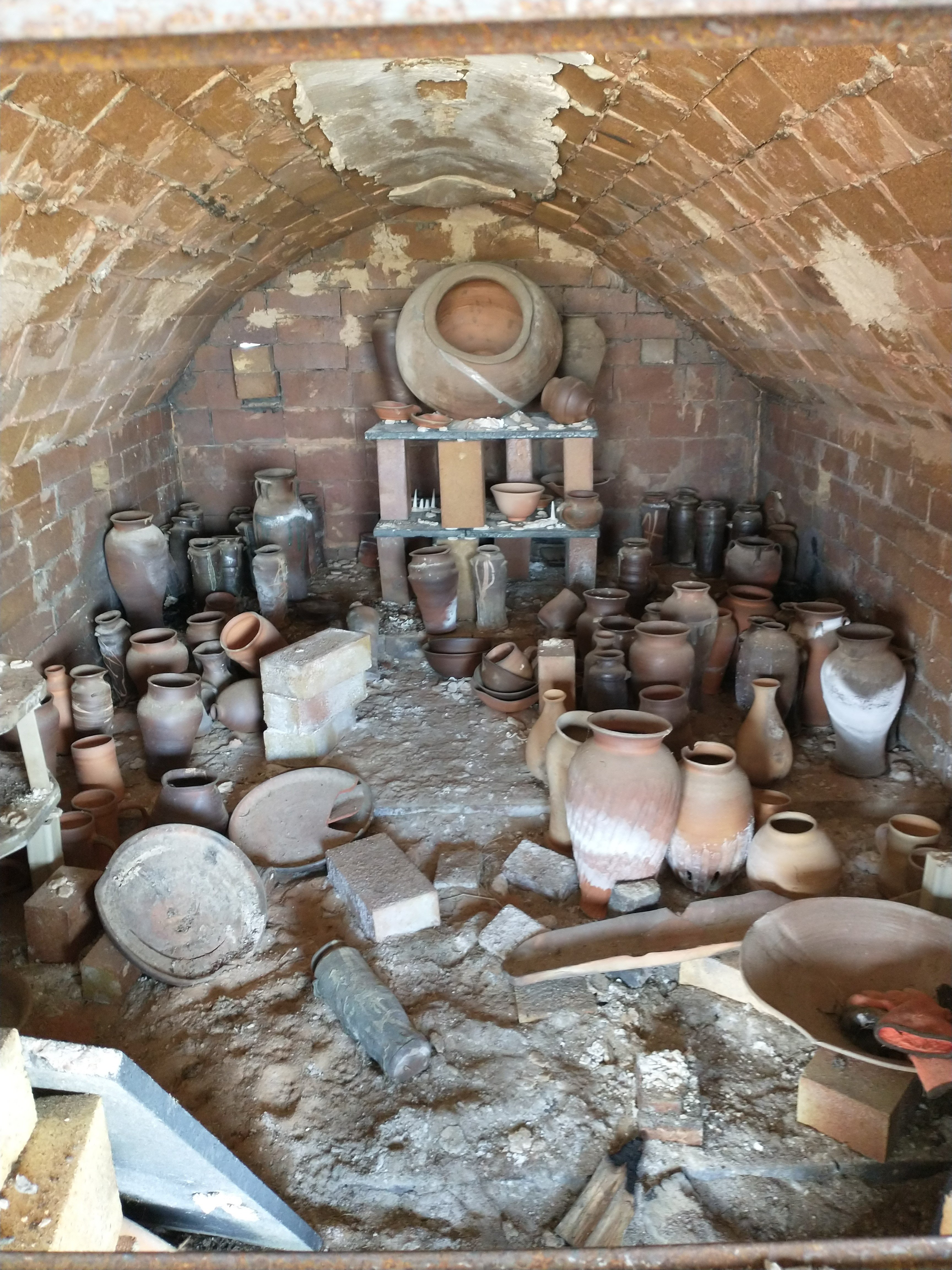
They fire it up twice a year, heaving pine logs into the front area through a small opening for 48 straight hours. Middleton and Winstead take shifts keeping the fire hot enough to reach above 2,000 degrees as it cures more than 100 pieces within. At its apex temperature, flames shoot high through the chimney in the night sky like a rocket blast.
The intense heat liquifies and fuses the ash into the clay forming a glistening surface. Like the horse-hair pots, each piece is unique.
The method is one of the most ancient techniques of firing pottery. Asian cultures were the first to do it, he said. Europeans were not able to reach that temperature level for firing pottery until the 1700s, he said.
One vase fired in the kiln stands about six inches tall and shines with a bluish, silvery patina from the ash mixed with patches of clay brown. The exterior is rough with particles that adhered to the clay as it was fired.
“I really like all the different surfaces,” Middleton said. “Ash surfaces are desirable to a lot of collectors.”
Middleton now has the rare combination of using a wood-fired kiln, a gas-powered kiln and an electric kiln. Only universities or large pottery schools have such a variety of options, he said.
“We’re the only studio in the area offering all that,” he said.
Electric kilns are the most common and easiest to use. These kilns fire with oxygen present in a controlled environment, creating the most consistent results, important for a potters who wants to replicate their work.
Gas kilns fire without oxygen, are less unpredictable and are good for creating one-of-a-kind pieces.
Wood-fired kilns are the most labor intensive, requiring much longer to cure the clay and creating their own ash glaze.
One of his more recent creations is a broad-shouldered bottle only an inch or so thick that looks something like a vintage rum flask used by a pirate.
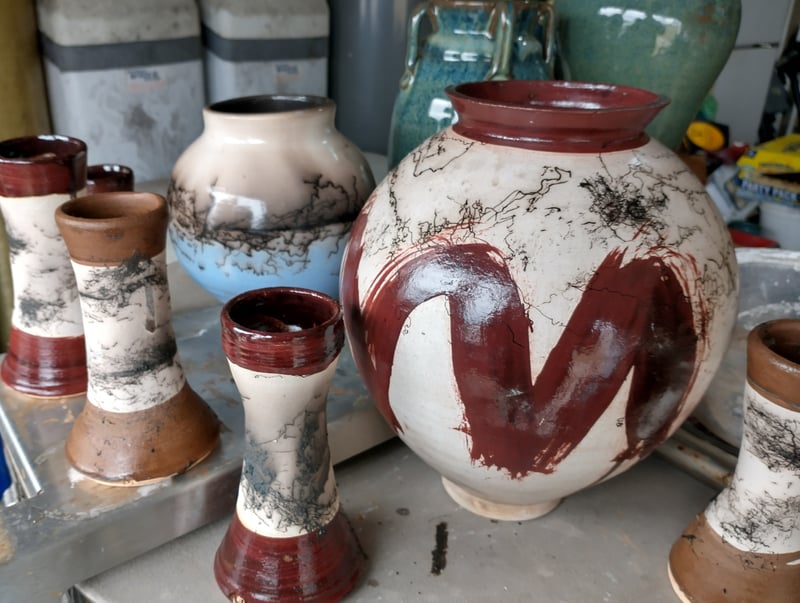
A wide mix of colors decorate the surface, but the highlight of the pieces are the rooster feathers seared into the glaze much like the horse-hair pots. The feathers come from feral roosters that roam Key West known as the Gypsy chickens. Proceeds from the first 10 pots sold go the Key West Wildlife Center. He has sold two of the decorative pots so far.
Middleton has begun creating the “Marks We Make” series of ceramics. One piece features the hand print of James Frye, a long-time educator in Hampton Roads known for inspiring youths. After retiring, he created a scholarship for students to further their education after high school.
Middleton is practicing an ancient Japanese style of placing shards of old pottery into a new pot, held together with gold. In a recent creation, he installed a fragment of native American pottery found along the Currituck Sound shoreline.
Middleton plans to construct or lease another building nearby that can serve as a workshop and classroom where he could teach others the skills of working clay. It could also be a place where other artists can work.
“It’s definitely a labor of love,” he said. “It’s not about the money. I would like one day, 100 years from now to be remembered for this work.”
Ornaments sell for $25 each. Horsehair pots sell for $95 to $150. Rooster feather bottles go for $250. For information and products visit michaelmiddletonceramics.com
These Stories on Manufacturing
No Comments Yet
Let us know what you think